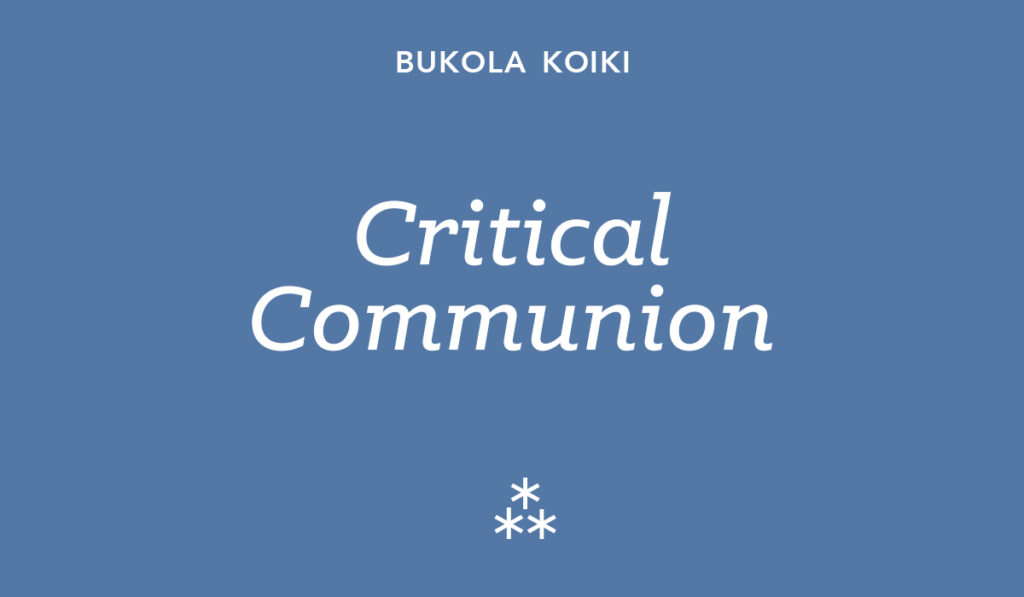by Bukola Koiki
Almost immediately after lockdowns began in cities and states across America in response to the COVID-19 pandemic, many art institutions, including the university Craft department that I worked for, had to think about the question: How do you teach studio Craft remotely?
The immediate pivot was to the now ubiquitous Zoom and, while it was not an easy transition, what became clear to me was the revelation of ways to teach studio Craft without our beloved wood, glass, textile, ceramics, and metals studios — an unfortunate sign of a previously-missed opportunity. I am not going to dismiss the inherent difficulty of having to teach a tactile art without the very materials that lend themselves to the haptic feedback required for mastery. Educators like me had a difficult time helping shell-shocked students recalibrate to being taught online on top of helping them mourn the loss of the community provided by their studios and classmates. Professors across the country had to brainstorm alternative materials for instruction. Paper replaced textile, Sculpey replaced clay, tin foil on cardboard stood in for etching plates — and in some cases we mailed students materials out of our own pockets to help them complete various assignments. Times had changed. We had to adapt and so did Craft.
What struck me at this time were the immediate possibilities of accessibility to Craft that we had created because we had put our minds to it as a community. It seemed that we had refused — or never made time — to create similar accessibility to Craft before a pandemic forced our hands.
What has now been made abundantly clear to me is that, however imperfectly, Craft can be taught virtually, with minimal supplies, empathetically and democratically. A favorite example of such a thoughtful pivot comes from artist/educator Jennifer Ling Datchuk, who mailed clay to her students so that they could interpret the idea of the selfie in ways that involved their hands, their face, and their camera to inventive and fantastic results. I have also personally experienced this shift in accessibility as evidenced by the number of artist talks and panel discussions in the Craft and Design fields that I am suddenly able to attend without concern for location and funds because they were hosted in Zoom and made free to all interested parties. These are experiences and knowledge gleaned that I would not have been privy to before this pandemic changed our notions of what was possible and who is deserving of such possibilities.
As a Black woman in the field, I am reminded every day and in almost every room I enter that I am still a rare bird in the world of Craft. I am here now, an artist and educator, by the grace of copious student loans and working my ass off. Many of the workshops and residencies I have attended, and even grad school, have been courtesy of grants and scholarships. Without them, there was no way that I could afford $1,000+, before travel costs, to attend workshops at any of the major Craft schools in the country. I am well aware that even those scholarships and grants are not available to everyone seeking them — if they even know about them. In the realm of financial accessibility, it would behoove these institutions to take a page out of the work of communities of color who have long explored various mechanisms such as sliding scale payments to lower or remove barriers to knowledge and opportunities of all kinds within their communities. If one can’t afford the more informal workshops to learn a medium, how likely are they to able to afford the undergrad or graduate school where they might actually encounter the teachers, practitioners, and mentors who would guide them in the Craft world on a long term basis? If I can’t afford these things, does that mean that I am unworthy of Craft skills and appreciation, scholarly knowledge, and theory? Are these gifts only available by incurring obscene amounts of debt? While I have gratitude for those experiences, I am also reminded that, had one decision or circumstance of my immigrant experience not gone as planned, I would be like many other BIPOC who feel shut out of, unwelcome in, and ignored by art institutions in the United States.
During this transitional time, I have also been made more aware of how these kinds of classes, workshops, and talks — suddenly available virtually — make/can make them more available to members of disabled communities. Many of the Craft schools in the United States are in remote locations that can be logistically challenging for some disabled people even if the school’s compound itself is accessible. If this pandemic encourages the creation of lower-cost virtual Craft workshops that would be a win. It is my hope that a disabled artist in the Craft community will be well paid to speak on this topic with more depth and clarity.
These are not new ideas and BIPOC and disabled communities have been at the forefront of this kind of divergent thinking out of necessity borne of neglect. The big questions that continue for me are: What excuses can we have from here on out for hoarding our Craft knowledge for ourselves? Can we keep up the elitism of the field and justify it in the face of the evidence that the democracy of Craft knowledge is possible? Can we afford to go back to the barriers and nepotism of before? A more accessible Craft world would certainly bring more BIPOC into the Craft communities and would allow us to do more than create the now-cliché diversity and inclusion beards for our institutions. The way that Craft has pivoted during this trying time makes it clear that it has been a choice to be all talk and no action. The marginalized and the poor, who need the joys of the arts most, don’t believe us anymore.

Bukola Koiki is a Nigerian-American transdisciplinary artist whose work strives to collapse the single-story of the immigrant experience by engaging and interpreting the liminal spaces she inhabits through research and explorations of linguistic phenomena, cultural ontologies, generational memory and more. Her current research and studio work examines and responds to the insidious language deployed in published texts, commercial advertising, and other media to serve and promote the British colonial exploitation of Nigeria’s resources and its people. Her multidimensional fiber works reflect her material and technical curiosity and include hand-pulled prints rendered with embroidered collagraph plates, giant beads employing Nigerian hair threading techniques, handmade and hand-dyed paper and Indigo dyed and hand-printed Tyvek head ties.
Koiki received her MFA in Applied Craft + Design from Pacific Northwest College of Art in 2015 and her BFA in Communication Design from the University of North Texas in 2006. She was nominated for the Textile Society of America’s Brandford/Elliott Award and named a 2019 Shortlist Finalist for the American Craft Council’s Emerging Voices Award. Koiki has exhibited nationally, including in Chicago, IL, and Portland, OR. Koiki and her work have been featured in American Craft magazine, Surface Design Journal, online on Art21 Magazine and Art Practical Journal websites and she has been interviewed on NPR. She was awarded the AICAD Teaching Fellowship at Maine College of Art from 2017–2019 and completed the Fountainhead Fellowship in the Craft/Material Studies Department at Virginia Commonwealth University School of the Arts in March 2020.

